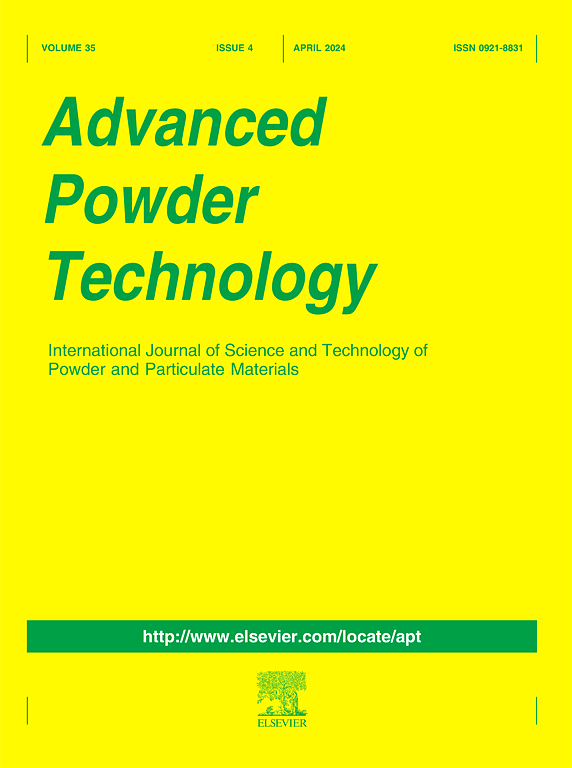Influence of cation species and pH on yield stress, floc formation, and sedimentation behavior in silica particle suspensions
IF 4.2
2区 工程技术
Q2 ENGINEERING, CHEMICAL
引用次数: 0
Abstract
This study examined how coagulation conditions—electrolyte concentration, cation species, and pH—influence yield behavior, sedimentation dynamics, and floc formation in amorphous silica suspensions. Zeta potential measurements showed that less hydrated cations adsorbed more strongly onto silica surfaces, reducing double-layer repulsion. Yield stress data indicated stronger interparticle attraction at high pH with poorly hydrated cations due to enhanced surface adsorption. Interestingly, in suspensions containing guanidinium (Gdm+)—the least hydrated cation—the yield stress decreased at concentrations above 2.0 M, implying that the large size of Gdm+ may cause steric repulsion at high concentrations, reducing the yield stress. Sedimentation tests showed that both sediment layer compression and floc structure were affected by pH and cation identity. Within the pH range of 4–8, sedimentation behavior aligned with yield stress trends, though deviations appeared at pH 10. Floc diameter measurements supported these findings, showing that larger flocs formed under conditions of stronger interparticle attraction, consistent with the yield stress data. Overall, cation hydration and pH strongly influenced interparticle forces and suspension behavior. These findings emphasize the significance of ion-specific effects in colloidal systems and provide insight into the rheological and stability properties of silica suspensions.

阳离子种类和pH对二氧化硅颗粒悬浮液中屈服应力、絮团形成和沉降行为的影响
本研究考察了凝固条件——电解质浓度、阳离子种类和ph——如何影响非晶二氧化硅悬浮液的屈服行为、沉降动力学和絮团形成。Zeta电位测量表明,较少的水合阳离子更强地吸附在二氧化硅表面,减少了双层排斥。屈服应力数据表明,在高pH下,由于表面吸附增强,低水合阳离子的颗粒间吸引力更强。有趣的是,在含有最少水化阳离子胍(Gdm+)的悬浮液中,当浓度高于2.0 M时,屈服应力降低,这意味着大尺寸的Gdm+可能在高浓度时引起位阻排斥,从而降低屈服应力。沉降试验表明,pH值和阳离子同一性对沉积物层压缩和絮体结构都有影响。在pH值为4 ~ 8的范围内,沉降行为与屈服应力趋势一致,但在pH值为10时出现偏差。絮凝体直径的测量支持了这些发现,表明在颗粒间吸引力更强的条件下形成了更大的絮凝体,这与屈服应力数据一致。总的来说,阳离子水合作用和pH值强烈影响颗粒间力和悬浮行为。这些发现强调了离子特异性效应在胶体体系中的重要性,并为二氧化硅悬浮液的流变性和稳定性提供了见解。
本文章由计算机程序翻译,如有差异,请以英文原文为准。
求助全文
约1分钟内获得全文
求助全文
来源期刊

Advanced Powder Technology
工程技术-工程:化工
CiteScore
9.50
自引率
7.70%
发文量
424
审稿时长
55 days
期刊介绍:
The aim of Advanced Powder Technology is to meet the demand for an international journal that integrates all aspects of science and technology research on powder and particulate materials. The journal fulfills this purpose by publishing original research papers, rapid communications, reviews, and translated articles by prominent researchers worldwide.
The editorial work of Advanced Powder Technology, which was founded as the International Journal of the Society of Powder Technology, Japan, is now shared by distinguished board members, who operate in a unique framework designed to respond to the increasing global demand for articles on not only powder and particles, but also on various materials produced from them.
Advanced Powder Technology covers various areas, but a discussion of powder and particles is required in articles. Topics include: Production of powder and particulate materials in gases and liquids(nanoparticles, fine ceramics, pharmaceuticals, novel functional materials, etc.); Aerosol and colloidal processing; Powder and particle characterization; Dynamics and phenomena; Calculation and simulation (CFD, DEM, Monte Carlo method, population balance, etc.); Measurement and control of powder processes; Particle modification; Comminution; Powder handling and operations (storage, transport, granulation, separation, fluidization, etc.)
 求助内容:
求助内容: 应助结果提醒方式:
应助结果提醒方式:


